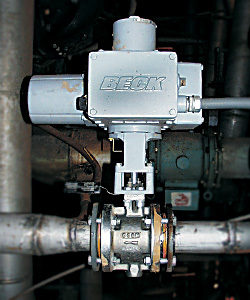 Improved process control is critical for today’s papermaking requirements
Improved process control is critical for today’s papermaking requirements
The ever growing need to improve quality, improve efficiency and meet more stringent environmental regulations, emphasizes the importance of improved process control. Throughout the industry, pulp and paper mills are making large investments in state-of-the-art control systems in an effort to attain the level of control performance required for success in this highly competitive global market.
Beck’s unique ability to provide quick, accurate and consistent positioning of final control elements allows mills to fully utilize the power of their control systems. This ability allows Beck actuators to significantly decrease process variability, improve product quality and reduce operating costs.
The control benefits provided by Beck electric actuators can be attributed to the unique design. Beck actuators feature accurate, durable positioning electronics, along with a no-burnout motor and efficient spur gearing. This design enables the Beck actuator to start and stop instantly–virtually eliminating dead time and overshoot regardless of load or process conditions.
Field Proven Results: Stock-to-Knotters Flow Control Valve / Pressure Control Valve
Original Pneumatic – Figure 2A
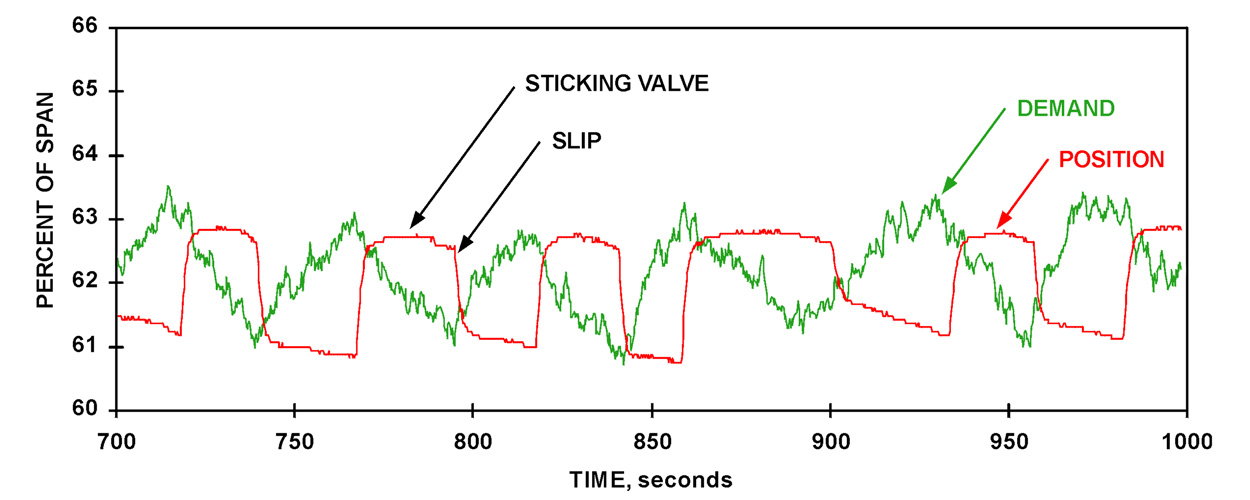
Figure 2A: In this stock-to-knotters flow control valve application, the pneumatically actuated valve exhibited a 2% limit cycle. The resulting cycle in the stock flow upset the knotter throughput, often causing plugging to occur. The cycle also destabilized upstream consistency control, which further contributed to knotter plugging.
Beck upon Install – Figure 2B
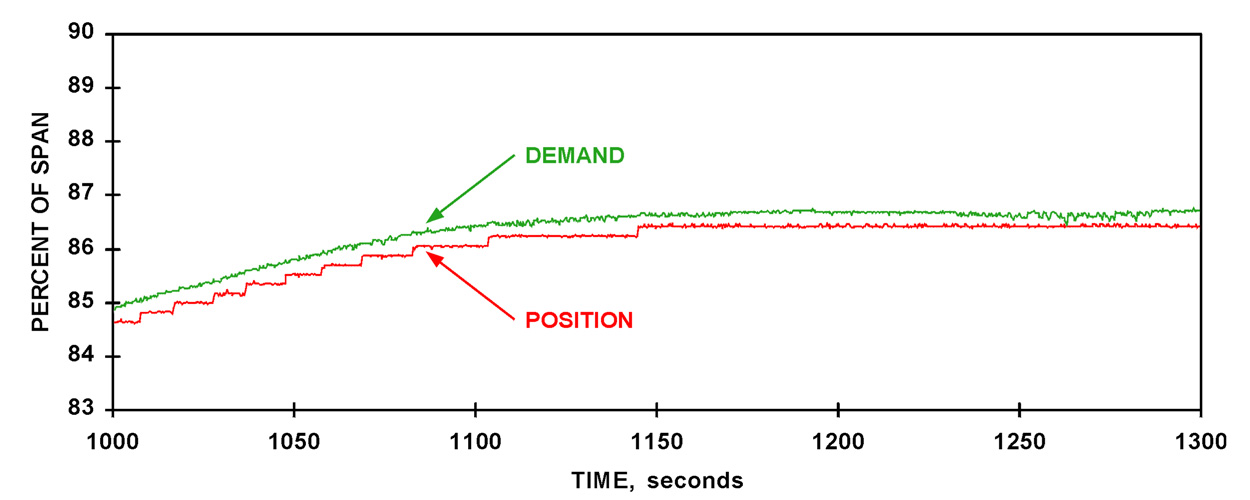
Figure 2B: A Beck control actuator, installed on the same valve, was able to closely track the controller output. This not only enabled the mill to tune the loop more appropriately, but aided in redesigning the control strategy to be more effective. Part of the redesign included eliminating the stock flow loop and converting to a pressure control valve. Unlike the pneumatic actuator, the Beck actuator provides the resolution, consistency and instantaneous response necessitated by the fast dynamics of pressure control.
Beck after 8 years – Figure 2C

Field Proven Results: Machine Chest Consistency Control Valve
Original Pneumatic Control – Figure 3A
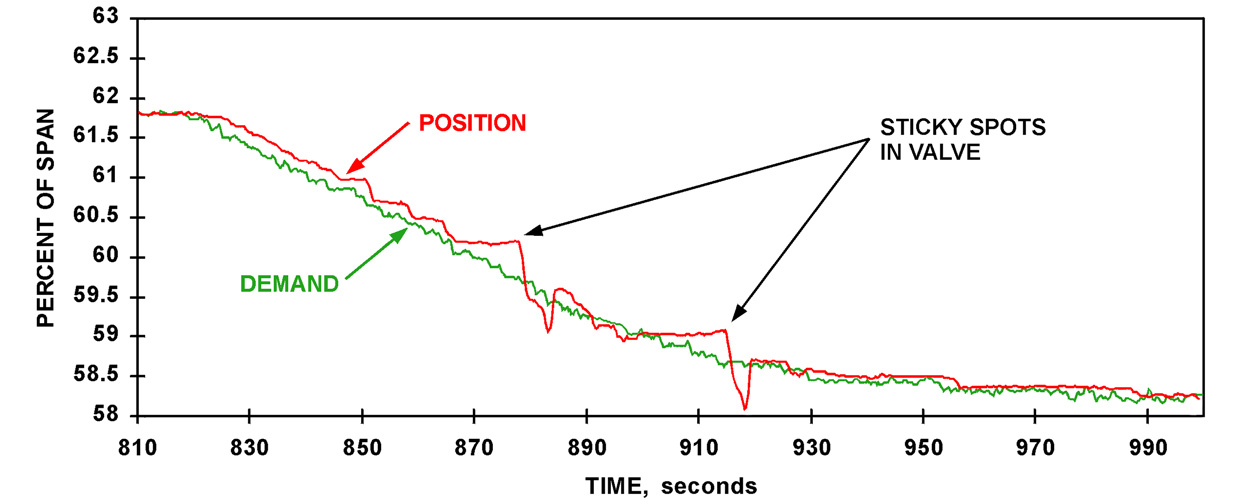
Figure 3A: In a thick stock dilution valve at another mill, this relatively new, pneumatically actuated valve performed adequately over much of its operating range. However, sticking occurred at approximately the 60% open position. This caused overshoot that affected the stock consistency. This subtle sticking problem is common and often develops quickly in new valves. The mill installed a Beck actuator to eliminate the problem. The instantaneous, full-torque starting capability of the Beck control actuator ensures that if valve stiction is present, it will not affect positioning performance.
Consistency % with Pneumatic – Figure 3B
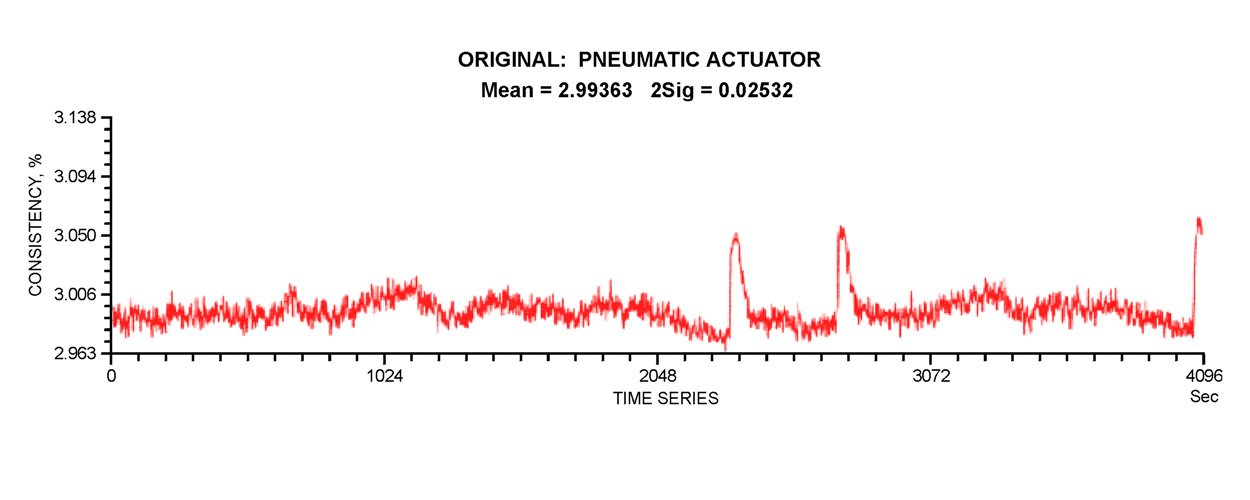
Figure 3B: This curve shows the negative impact the subtle stick problem (see Figure 3A) had on stock consistency.
Consistency % with Beck – Figure 3C
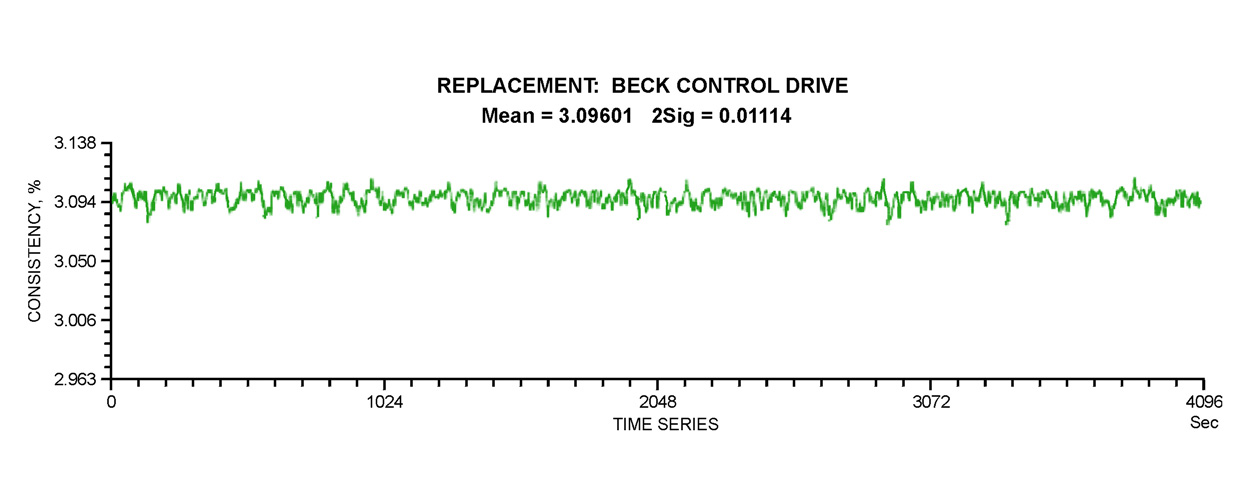
Figure 3C: By installing a Beck electric actuator, the negative impact of the sticking problem was completely eliminated. In addition, the consistency meter was moved closer to the control valve reducing dead time. This, combined with the Beck actuator, yielded an overall improvement in consistency control.
Pneumatic actuators are subject to inherent characteristics that limit and disrupt control loop performance. Many recent developments in this technology center on advanced diagnostics to help detect and predict these problems, but the compressibility of air remains the major problem source. As such, the overall performance of pneumatic actuators varies as a function of frictional and dynamic load, process conditions, valve condition, and the performance of actuator accessories like the I/P transducers, positioners, and boosters. This results in inconsistent and often wide deadbands, poor resolution, sluggish response, and overshoot. Even when pneumatic actuators perform well when new, these problems become increasingly prevalent and unpredictable over time. Heat, humidity, contamination, and air quality all serve to increase performance degradation and inconsistency, often making excessive maintenance necessary to maintain acceptable control.
“Stick and slip” is one of the most common pneumatic actuator problems. This condition occurs when an actuator builds pressure to overcome a static load (usually frictional, but not always). As the pressure builds, the final control element does not respond, and therefore the controller continues to increase the demand. When the air pressure is high enough to initiate movement, the actuator takes off and overshoots the correct position. This can result in “limit cycling”–causing the controller to continuously cycle.
Stick and Slip
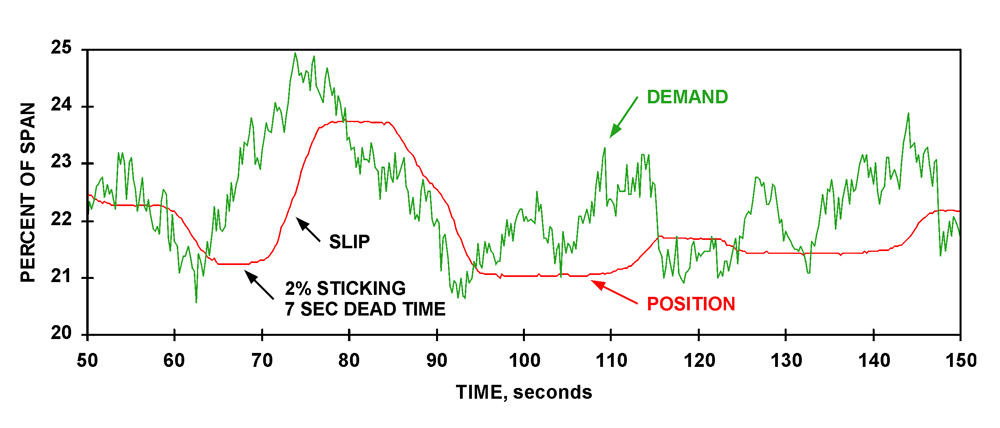
Figure 1: This data is from a consistency control loop in a North American mill. It demonstrates the problem of stick and slip. As shown, a 2% change in demand was required to initiate response. In this case, the result was 7 seconds of dead time.
Typical electric actuators have problems of their own. Many designs incorporate high-speed induction motors that do not stop instantaneously and require a limited duty cycle to prevent overheating. In addition, most utilize inefficient worm gears, which can wear quickly, particularly within actuators installed in active loops. These problems dictate the use of wide deadbands, which can severely limit the resolution of a final control element. Another significant concern is the overall reliability of typical electric actuators. The electronics often cannot withstand harsh environmental conditions and cause costly control downtime. Beck control actuators are designed to eliminate the problems of both pneumatic and conventional electric actuators. Beck actuators provide consistent and precise performance despite the effect of changing process conditions–without sticking, slipping or degrading over time.
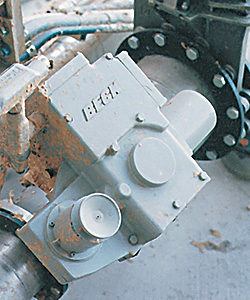 Beck control actuators provide field-proven solutions to control problems
Beck control actuators provide field-proven solutions to control problems
Control loop performance is only as good as the performance of the control valve. It is a well-documented fact that many industrial control loops function poorly as a result of valve actuation problems. Beck control actuators eliminate the problems caused by both pneumatic and typical electric actuators, and maximize the potential of control systems.
Unlike pneumatic actuators, Beck actuators provide consistent and precise performance over time regardless of changing process conditions. This is accomplished through the unique Beck design, which provides a number of key performance advantages including:
- Repeatable positioning down to 0.1% resolution
- Will not STICK, SLIP or OVERSHOOT
- Instantaneous starts and stops
- No performance degradation over time or with changing loads
- No duty cycle limitations
- Rated from (-40) to 85°C. (185°F.)
- Requires little or no maintenance
Download a PDF copy of our Pulp and Paper brochure
Motor
The Beck Motor: 100% Availability
Beck’s unique motor design makes the precise, reliable performance of the actuators possible. This no burnout motor ensures that the actuator is available 100% of the time. There are no duty cycle limitations typical of most electric actuators, so the actuator performs as the loop requires rather than the loop performing as the actuator permits.
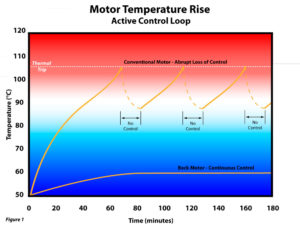
The Beck Motor:
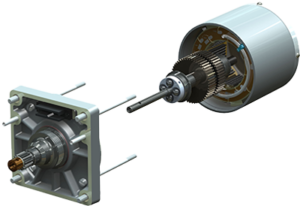
- Reaches full speed and torque in milliseconds and stops in milliseconds, eliminating dead time.
- Provides extremely accurate and repeatable positioning for modulating applications.
- Will not coast or overshoot the desired position.
- Draws low current (0.16 A to 3.0 A). The low power consumption permits easy use with uninterruptible power supplies.
- Uses double-lipped, grease-sealed bearings for maintenance-free operation.
- And . . .Never overheats or burns-out; even under demanding modulating control or stalled conditions.
Electronics
Digital Electronics: Repeatable Control, Simple Operation, and Diagnostic Capabilities
Our field-proven electronics provide excellent position control in response to modulating control signals. This maximizes control loop performance by ensuring that the actuator responds exactly as the control loop requires.
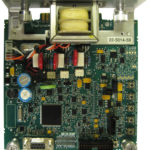 The DCM-3 is equipped with a local interface panel for pushbutton calibration functions without the need for external devices or software. LED diagnostic lights display a number of status conditions.
The DCM-3 is equipped with a local interface panel for pushbutton calibration functions without the need for external devices or software. LED diagnostic lights display a number of status conditions.
The DCM-3 is also equipped with a HART® communications interface to provide bidirectional digital communications over the existing analog demand wiring—providing access to the added functions and information without interfering with control or requiring new wiring. Communications can be established either remotely or locally using any standard HART®-based communication tool and is compatible with common asset management systems. Optionally, the DCM can be equipped with Foundation Fieldbus® or Profibus PA® communication capability.
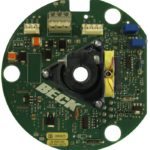 Beck’s Contactless Position Sensor (CPS) also resides within the actuator, and provides reliable internal position feedback to the DCM for position control. The DCM also uses the sensor signal to source a 4–20 mA external position signal for remote monitoring of actuator position. Unlike typical position sensors, the CPS does not wear due to its contactless design.
Beck’s Contactless Position Sensor (CPS) also resides within the actuator, and provides reliable internal position feedback to the DCM for position control. The DCM also uses the sensor signal to source a 4–20 mA external position signal for remote monitoring of actuator position. Unlike typical position sensors, the CPS does not wear due to its contactless design.
Limit Switches
Over-travel Limit Switches
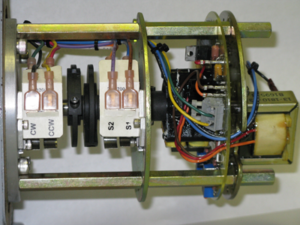 Beck actuators include heavy-duty, single-pole, double-throw (SPDT) switch mechanisms for electrical over-travel protection. Switch cams will not slip because each is mounted to the shaft by an integral, tangential clamping means—with no set screws to mar the shaft.
Beck actuators include heavy-duty, single-pole, double-throw (SPDT) switch mechanisms for electrical over-travel protection. Switch cams will not slip because each is mounted to the shaft by an integral, tangential clamping means—with no set screws to mar the shaft.
Every actuator is equipped with two over-travel limit switches. Optionally, actuators can be equipped with up to four auxiliary switches that can be set to operate at any desired point of actuator travel, thus providing discrete inputs for control or indication.
Common throughout most Beck actuator models, the SPDT switches provide the following:
- A maximum rating of 6 A at 120 V ac (three times the maximum motor current for most models) to ensure long life.
- Auxiliary switches are field-adjustable with infinite positioning throughout the actuator’s travel range.
- May initiate secondary functions or provide remote indication of actuator position.
Drive Train
Drive Train: Power and Durability
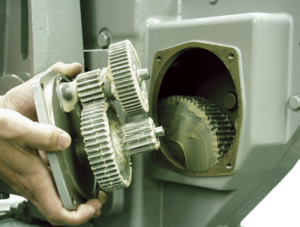 Beck’s durable gear train maintains accurate, consistent positioning even under the demanding conditions of an active control loop.
Beck’s durable gear train maintains accurate, consistent positioning even under the demanding conditions of an active control loop.
-
- Gear trains employ a unique, all spur gear construction using only heat-treated alloy steels and ductile iron.
-
- Efficient, wide-faced spur gears ensure long life and eliminate wear-induced backlash and positioning inaccuracies common in worm gear and “Scotch-yoke” designs.
-
- Integral self-locking mechanism ensures that actuators hold a minimum of 200% of rated torque with the motor de-energized.
-
- Durable design provides up to 4 days of protection against intermittent or extended accidental stalls.
- Stall protection is provided by the DCM. If the motor tries to run in one direction for more than 300 seconds, the DCM-2 will shut off power to the motor and a status indication LED will activate indicating a stall.
Local Manual Control
Local Manual Control
All Beck actuators are built with local positioning capabilities. An electric Handswitch allows electrical local operation of the actuator, while a convenient Handwheel, or Handcrank on some high torque actuators, allows manual positioning of the actuator output shaft without electric power.
Handswitch
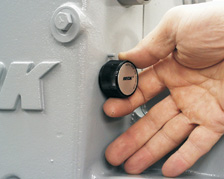
The electric Handswitch allows the actuator to be positioned locally and is very useful for the initial setup of the actuator and linkage. It also serves as a diagnostic tool or a backup control device in the event the loop controller or demand signal malfunctions.
Handwheel
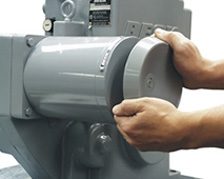
Even in the absence of power, and with full load applied, the actuator output shaft can be manually positioned using the easy-to-turn, spoke-free Handwheel. No clutch mechanism is required and mechanical stops protect against manual overtravel.
Housing
Housing: Superior Protection and Convenient Access to Components
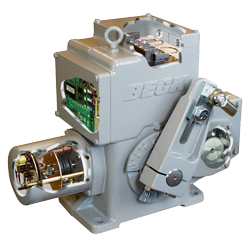 Beck actuators feature a cast aluminum body with individual compartments to protect components from moisture and dirt, and allow easy access for installation and calibration.
Beck actuators feature a cast aluminum body with individual compartments to protect components from moisture and dirt, and allow easy access for installation and calibration.
- Precision-machined aluminum alloy castings with corrosion-resistant polyurethane paint provide a rugged, dust-tight, weatherproof Type 4X enclosure.
- Individual compartments protect all major components: Motor, DCM-2, CPS, gear train and installation wiring terminal board.
- Gasketed covers provide extra protection for abusive indoor environments and harsh outdoor climates.
- Each compartment can be accessed without exposing other components to the environment.
- Output and Handwheel shafts are sealed with weatherproof, double-lip cartridge seals.
Linkage
Linkage: Beck Linkage Kits and Link-Assist™ Program Ensure the Best Connection
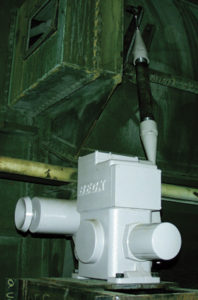 The unique design of the crank arm allows infinite position adjustment to simplify installation. Engineered linkage kits are available to complete the connection from the crank arm to the damper. Once the connection is made, the linkage length may be adjusted, simplifying the final mechanical calibration. Also, Beck rod ends incorporate a bearing to compensate for some lateral misalignment.
The unique design of the crank arm allows infinite position adjustment to simplify installation. Engineered linkage kits are available to complete the connection from the crank arm to the damper. Once the connection is made, the linkage length may be adjusted, simplifying the final mechanical calibration. Also, Beck rod ends incorporate a bearing to compensate for some lateral misalignment.
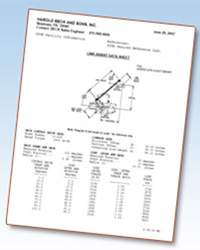 Beck’s Link-Assist™ program provides a printout showing the optimum actuator and linkage configuration for the application. The linkage arrangement can be characterized to match the torque profile of the application. Request this free service to save time, simplify installation and ensure the best performance at the lowest possible cost.
Beck’s Link-Assist™ program provides a printout showing the optimum actuator and linkage configuration for the application. The linkage arrangement can be characterized to match the torque profile of the application. Request this free service to save time, simplify installation and ensure the best performance at the lowest possible cost.

